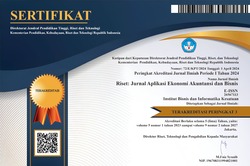BUSINESS RISK ANALYSIS IN ARI WIBOWO'S CENTRAL TILE INDUSTRY IN LOHJINAWI VILLAGE, PRINGSEWU REGENCY IN 2018 - 2020
DOI:
https://doi.org/10.37641/riset.v3i2.99Keywords:
Financial Leverage, Operating Leverage, Degree of Operating LeverageAbstract
Business risk is the potential deviation of corporate results and financial results because the company enters a certain business with a typical industrial environment and uses certain technologies. In business there are so many decisions or actions that must be made, it makes more and more risks that may occur as a result. The purpose of this research is to find out how big the Business Risk Central Tile Industry in Lohjinawi Village, Pringsewu Regency,The analysis was carried out descriptively, using standard deviation of ROE; Financial Leverage; Operating Leverage namely the sensitivity of EBIT to changes in the company's sales; as well as Degree of Operation Leverage (DOL). The results of the analysis show that: 1) ROE, has increased due to an increase in Sales and an increase in EAT, and vice versa; 2)The use of debt can increase the Company's ROE; 3) Operating Leverage, where EBIT is very sensitive to changes in company sales; 4)Degree of Operating Leverage (DOL) measures what percentage of EBIT changes if sales; 2018-2019 of 1.50x which means DOL of 150% that every 100% increase or 1x sales will cause an increase in operating profit of 1.50x otherwise, if sales decrease 1x then operating profit will decrease by 1.50x. While the year 2019-2020 amounted to 2.01x which means a DOL of 201% indicates that every 100% or 1x decrease in sales will cause a 2.01x decrease in operating profit. On the other hand, if sales decrease 1x, operating profit will decrease by 2.01x.







